Negative Drug Screen Results: What You Need to Know
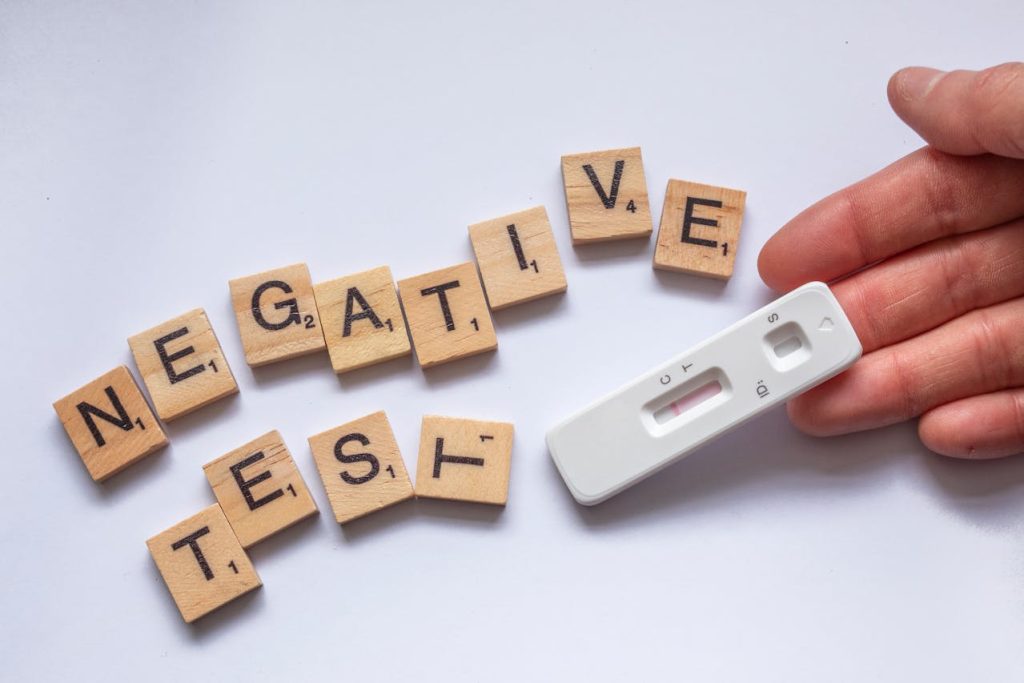
What Is a Drug Screen?
A drug screen or drug test is a procedure used to detect the presence of illicit substances or prescription drugs in a person’s system. These tests are commonly conducted in various settings, including:
- Pre-employment testing: Employers may require drug testing before hiring to ensure a safe, drug-free workplace.
- Random testing: Some employers conduct random drug tests to maintain ongoing compliance with workplace drug policies.
- Post-accident testing: After workplace accidents, employees may be tested to determine whether drug use contributed to the incident.
- Reasonable suspicion testing: If an employee is suspected of being under the influence while at work, they may be tested.
Drug screens are often a key part of a company’s drug-free workplace program, especially in industries where safety is paramount, such as transportation, construction, and healthcare.
What Does a Negative Drug Screen Result Mean?
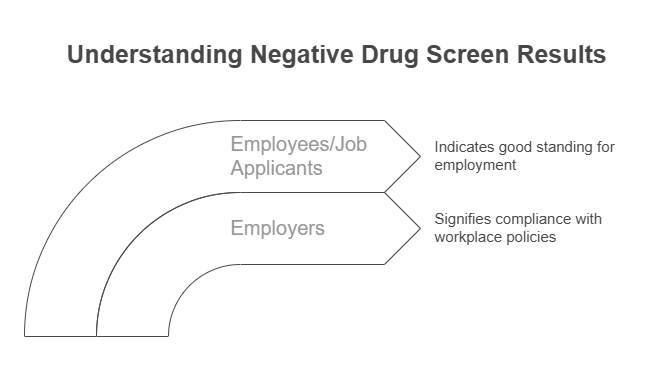
A negative drug screen result means that no traces of illicit drugs or substances were detected in the person’s sample. This is the desired outcome of most drug tests, as it indicates the individual is not currently using prohibited substances.
For employers, negative drug test results are generally a sign that the employee or candidate complies with workplace policies, and they are often a prerequisite for finalizing hiring decisions or maintaining job security.
For employees or job applicants, a negative result typically signals that they are in good standing and may proceed with employment or retain their position. However, it’s important to note that a negative result can also lead to further screenings or discussions depending on the context of the test.
Types of Drug Tests and How Negative Results Are Reported
There are several different types of drug tests used to screen for substance use. The type of test performed impacts both the detection window for substances and how the results are reported.
- Urine Drug Tests:
- Most common type of drug test in employment settings.
- Drugs such as marijuana, cocaine, opiates, amphetamines, and benzodiazepines are detected through urine.
- Negative result: No drug traces are found in the urine sample.
- Saliva Drug Tests:
- This type of test detects recent drug use and is usually less invasive than urine tests.
- Negative result: The saliva sample is free from detectable drug metabolites.
- Blood Drug Tests:
- Most accurate, but also more invasive. Blood tests are often used in post-accident scenarios or for legal purposes.
- Negative result: No drugs are detected in the bloodstream, and the person’s blood is clean.
- Hair Follicle Drug Tests:
- This test detects drug use over a longer period (usually 90 days).
- Negative result: No traces of drugs are found in the hair sample, indicating the person has not used drugs in the period leading up to the test.
The General Process of Drug Testing
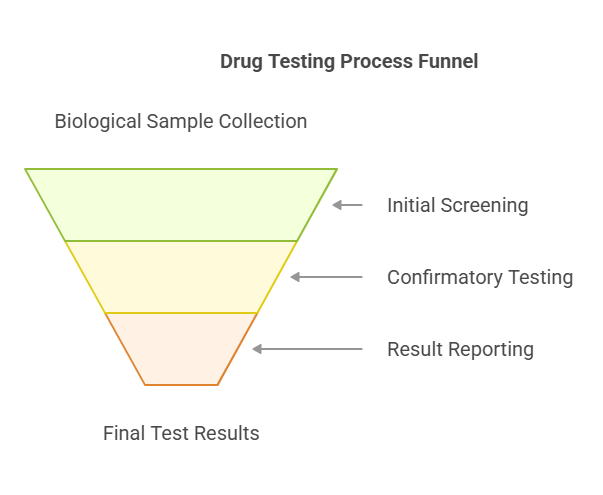
The drug testing process generally follows a series of steps:
- Collection: A sample (urine, blood, saliva, or hair) is collected from the individual being tested. For urine or saliva tests, this is usually done on-site at a clinic or workplace, while blood tests are typically performed at a medical facility.
- Screening: The sample is screened for the presence of drugs using specific testing procedures. For instance, a urine sample might first undergo an immunoassay to detect common drugs like marijuana or cocaine.
- Confirmation: If the initial test is positive, a more accurate, confirmatory test (such as gas chromatography-mass spectrometry for urine tests) is performed to rule out false positives.
- Result Reporting: Once the confirmatory testing is completed, results are sent to the employer, or the designated recipient. A negative result simply means no illicit drugs were detected in the sample.
What Constitutes a Negative Result?
A negative result indicates that no illicit or banned substances were found in the test sample. This means that, in the case of most employment-related drug tests, the individual has passed the test and is cleared from suspicion of drug use, assuming no other issues arise (such as procedural errors or concerns over sample integrity).
A negative result is crucial for employment opportunities and can directly affect a candidate’s ability to move forward in the hiring process. It also allows employees to avoid disciplinary actions, ensuring continued employment in most cases.
Summary of Key Points:
- A negative drug test result means no drugs were detected in the sample provided.
- Negative results are important for both employers (for hiring or compliance) and employees (for job security).
- Different types of drug tests include urine, saliva, blood, and hair tests, each with its own detection window and processing methods.
- The process of drug testing involves sample collection, screening, confirmation, and result reporting.
Implications of a Negative Drug Test Result for Employees
A negative drug screen result holds several positive implications for employees and job candidates. Let’s break down the most common outcomes:
- Employment Opportunities:
- Clearance for Employment: In pre-employment testing, a negative drug test result typically signals that the applicant is eligible to proceed with hiring. Employers are generally looking for candidates who are drug-free and fit to work in environments that require safety, responsibility, or legal compliance.
- Retaining Employment: For employees who undergo random or scheduled testing as part of ongoing workplace policies, a negative result confirms that the employee is abiding by company drug-free policies, reducing the risk of termination or disciplinary actions.
- Job Security:
- A negative result helps solidify job security for an employee. For those in industries where safety is critical, such as transportation, healthcare, and manufacturing, a clean drug test can prevent the employee from being sidelined or facing disciplinary action.
- Prevention of Disqualification: In certain industries, especially those regulated by government entities, employees who fail drug tests risk disqualification from operating certain machinery, vehicles, or equipment, leading to job loss. A negative result ensures that employees continue to meet these critical standards.
- Opportunities for Promotion:
- For employees already in the workforce, passing a drug test with a negative result can also be a factor when seeking promotions or advancement opportunities. Drug-free status demonstrates reliability and trustworthiness to higher management, which may influence decisions regarding career progression.
Employer’s Response to Negative Drug Screen Results
From the employer’s perspective, a negative drug screen result is typically seen as a positive outcome for the company’s drug-free workplace policies. Here’s what employers typically do with negative results:
- Completing the Hiring Process:
- If the drug test is part of the pre-employment process, a negative result will allow the employer to proceed with making a formal job offer to the candidate. In most cases, the result can be one of the final steps in completing the hiring process.
- Ensuring Workplace Compliance:
- Employers who conduct random drug tests or post-accident tests rely on negative results to maintain a safe and compliant work environment. By ensuring that employees are drug-free, companies avoid the potential legal ramifications and safety concerns that come with employing individuals who use drugs on the job.
- Notifying the Employee:
- Employers will typically notify employees about their negative drug test results, often in writing. In many cases, this happens alongside other communications such as onboarding documents, job contracts, or safety guidelines.
- If the drug test is part of an ongoing employment monitoring program, a negative result confirms the employee’s compliance with the company’s drug-free policy.
How Employees Can Respond to Negative Drug Screen Results
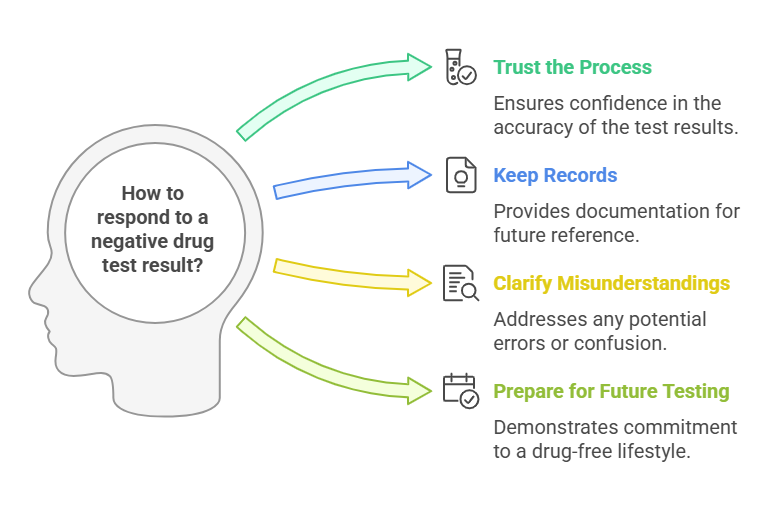
For candidates and employees who receive negative drug test results, it is generally a positive outcome, but it’s essential to understand what the result means and how to respond appropriately.
- Trust the Process:
- Understand the Integrity of the Process: Drug tests are usually highly accurate. If the result is negative, it is likely that the testing process was completed without issues. Employers and employees should be confident that results are a reliable reflection of the individual’s drug use history (or lack thereof).
- Keep Records:
- Document the Results: Employees and candidates should keep a record of the negative test results. This documentation may be important for future reference, especially if there are questions raised by other employers or during future employment verification processes.
- Clarify Misunderstandings:
- In rare cases, there could be misunderstandings or confusion over the type of test performed, or testing conditions. If an employee has concerns or believes there may be an error in their results, they should contact the testing facility or their employer for clarification.
- Prepare for Future Testing:
- Negative drug tests provide an opportunity to demonstrate commitment to staying drug-free in the future. Employees who know that ongoing drug screening is part of their role should continue to comply with company policies and maintain a clear drug-free record.
Advice for Candidates with Negative Results
Candidates who face a negative drug test result as part of the hiring process should consider the following:
- Positive Reflection of Professionalism:
- A negative drug test result often highlights a candidate’s responsibility and professionalism, making them a more attractive hire for employers who value a drug-free workplace.
- Immediate Action:
- If a candidate is awaiting a final job offer, the negative result will often expedite the hiring process. Candidates should stay proactive and reach out to the employer to ensure that there are no further requirements in the hiring process.
Role of ExactBackgroundChecks in Drug Screening Services
For both employers and candidates, working with a trusted background check and drug screening service can streamline the process, ensuring fast, accurate results and compliance with workplace policies. ExactBackgroundChecks is a provider that offers a range of drug testing solutions, including:
- Pre-employment drug screening to verify job applicants’ compliance with company drug-free policies.
- Random and routine drug testing services for ongoing employee monitoring.
- Post-accident drug testing to ensure a safe environment after workplace incidents.
With services like instant results, accurate reporting, and compliance with legal standards, ExactBackgroundChecks supports both employers and employees in navigating the drug screening process with ease.
Drug Test Types and Detection Windows
It’s also important to understand the various drug test types and their detection windows. This can provide clarity on when a test is most likely to yield a negative result. Here’s a table summarizing the most common types of drug tests and their typical detection windows:
| Drug Test Type | Detection Window | Commonly Tested Substances |
|---|---|---|
| Urine Test | 1 to 7 days | Marijuana, cocaine, opiates, amphetamines, benzodiazepines |
| Saliva Test | 1 to 2 days | Marijuana, cocaine, opiates, amphetamines |
| Blood Test | Hours to 1 day | Cocaine, marijuana, opiates, alcohol |
| Hair Follicle Test | Up to 90 days | Marijuana, cocaine, opiates, amphetamines, benzodiazepines |
Key Takeaway: The window for detection varies by the type of drug and the testing method used. A negative result confirms that no drugs were detected within the detectable period.
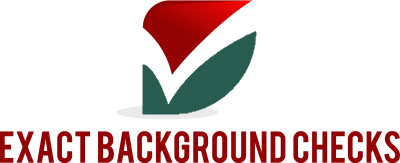
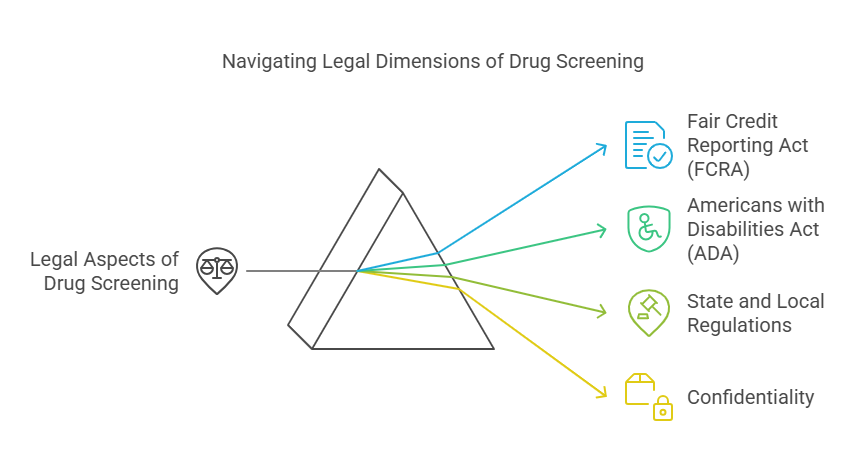



This is a comprehensive guide on drug screening and the significance of negative results! It’s great to see how these tests ensure workplace safety and compliance while maintaining fairness for employees. Thanks for sharing such detailed and valuable insights!
This article provides a clear and insightful overview of drug screening, emphasizing its importance in workplace safety and compliance. It effectively explains the implications of a negative drug test result for both employers and employees, while also highlighting key legal considerations. Understanding the drug testing process helps ensure fairness, accuracy, and compliance with regulations.
Great post! Negative drug screen results are often misunderstood, but it’s crucial to know the factors that can affect them. It’s important for both employers and employees to understand how these results impact hiring decisions or workplace policies.